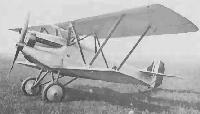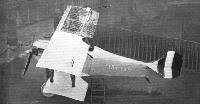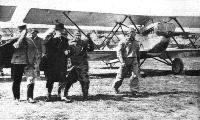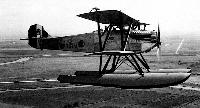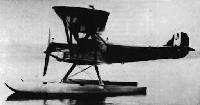
Fiat CR.20
Одноместные истребители Fiat CR.20 для своего времени строились в большом количестве. Этими самолетами была укомплектована знаменитая пилотажная группа ВВС Италии. CR.20 принимали участие в боях на заключительном этапе покорения Италией Ливии, затем в войне с Абиссинией, завершившейся победой Италии в 1936 году. Не встречая противника в воздухе, итальянцы использовали CR.20 для нанесения ударов по наземным целям - как в Ливии, так и в Эфиопии. Различные модификации биплана использовались как учебно-тренировочные самолеты даже в конце 1930-х годов.
Классический полутораплан отличался аэродинамически чистым фюзеляжем. Самолет имел в основном металлическую конструкцию с покрытой аэролаком полотняной обшивкой, лишь носовая часть фюзеляжа была обшита панелями из легкого металла. Самолет проектировался под новый рядный мотор жидкостного охлаждения Fiat A.20, испытания проходили четыре прототипа. Первый полет первый прототип выполнил в Турине 19 июня 1926 года. Осенью 1927 года истребитель вызвал ажиотаж на Парижском авиасалоне. Внешний вид самолета носил отчетливый почерк конструктора Розателли - W-образные стойки бипланной коробки и форма вертикального оперения.
Серийное производство началось в 1927 году, в 1927-1929 годах построили 124 истребителя, 107 из которых поступили на вооружение ВВС Италии (88 - постройки "Fiat", 19 - постройки CMASA), 15 машин были проданы Литве. 17 очень похожих самолетов в варианте гидросамолета, построенных в 1928 году фирмой "Macchi", обозначались CR.20 Idro (или ICR.20). Двухместный учебно-тренировочный истребитель выпускался под обозначением CR.20B с 1927 года, эти самолеты использовались ВВС Италии, по четыре самолета экспортировали в Австрию и Венгрию.
Недостатком сухопутного истребителя CR.20 являлось фиксированное шасси с хвостовым костылем. Основные опоры шасси CR.20bis, появившегося в 1929 году, снабдили масляно-пневматическими амортизаторами и колесами с тормозами. На этой модели также доработали конструкцию крыла. В 1930-1931 годах "Fiat" собрал 211 самолетов CR.20bis, включая неустановленное количество подварианта CR.20AQ с мотором A.20AQ мощностью 425 л. с. CR.20AQ обладали большим практическим потолком, но отличались большим расходом топлива и, за счет этого, меньшей продолжительностью полета. Австрия закупила по 16 самолетов CR.20bis и CR.20AQ (два из них разбились при выполнении приемо-сдаточных полетов), Венгрия - двенадцать машин и Парагвай - пять.
Финальным серийным вариантом стал CR.Asso, представлявший собой сочетание планера CR.20bis с мотором Isotta-Fraschini Asso Caccia мощностью 450 л. с. Мотор воздушного охлаждения получил элегантный капот. Единственной крупной конструктивной доработкой планера (помимо моторамы и капота) стало измененное оперение со стабилизатором большей площади. Всего в 1932-1933 годах построили 204 самолета CR.Asso. В строевых частях эти машины были популярны, а в пилотажной группе ими заменили CR.20bis. Самолеты семейства CR.20 использовались для различных испытаний, в частности для отработки щелевых предкрылков типа Хэндли Пейдж.
Тайной окутан один CR.20, по сообщениям проданный в СССР. Четыре самолета в августе 1929 года принимали участие в конкурсе на истребитель для ВВС Польши и других стран "Малой Антанты" (Чехословакия, Румыния и Югославия). На вооружении ВВС Венгрии CR.20bis и CR.20AQ состояли с 1932 по 1936 год, когда им на смену пришли CR.32; в Австрии использовались до 1938 года, когда страну аннексировала Германия. После аншлюса австрийские CR.20 получили опознавательные знаки Люфтваффе и непродолжительное время использовались в авиационных школах германских ВВС. Парагвай использовал пять своих истребителей в войне 1932-1935 годов с Боливией.
В ВВС Италии CR.20 играли доминирующую роль. В течение нескольких лет ими были вооружены почти все истребительные эскадрильи, а CR.20 Idro состояли на вооружении эскадрилий гидросамолетов-истребителей.
ТАКТИКО-ТЕХНИЧЕСКИЕ ХАРАКТЕРИСТИКИ
Fiat CR.20bis
Тип: одноместный истребитель
Силовая установка: один V-образный мотор Fiat A.20 мощностью 410 л.с. (306 кВт)
Летные характеристики: макс, скорость на уровне моря 270 км/ч; время набора высоты 5000 м -13 мин 37 с; практический потолок 8500 м; продолжительность полета 3 час
Масса: пустого 980 кг; максимальная взлетная 1400 кг
Размеры: размах крыла 9,80 м; длина 6,70 м; высота 2,75 м; площадь крыла 26,65 мг
Вооружение: два 7,7-мм пулемета Vickers, установленных неподвижно сверху в носовой части фюзеляжа
Описание:
- Fiat CR.20
- Flight, December 1926
The Paris Aero Show 1926 - Flight, June 1929
OLYMPIA AERO SHOW 1929
Фотографии
-
Авиация и Время 2003-02 / М.Жирохов, М.Пруцаков - "Красный" итальянец /Портреты/
Fiat C.R.20 из 70-й АЭ 3-го ИАП ВВС Италии. Брешиа, 1931г.
-
АвиаМастер 2004-08 / М.Жирохов, С.Вахрушев - Жил отважный "таракан"...: летчик-истребитель Рафаэль Чианезе /Авиация в лицах/
"Фиат" CR-20 из итальянской пилотажной группы, в составе которой летал Рафаэль Чианезе, июнь 1936г.
-
АвиаМастер 2004-08 / М.Жирохов, С.Вахрушев - Жил отважный "таракан"...: летчик-истребитель Рафаэль Чианезе /Авиация в лицах/
Истребитель "Фиат" CR-20, изображавший самолет "потенциального противника" в летной школе "Литторио", где учился Рафаэль Чианезе
-
Мировая Авиация 129
Fiat CR.20 рекламировался как истребитель с вооружением из четырех пулеметов, но обычно самолет нес только два пулемета в фюзеляже - как большинство истребителей межвоенного периода (хотя на любом CR.20 можно было установить еще два пулемета по бортам фюзеляжа). Изображен самолет ВВС Венгрии.
-
АС 1993-01 / М.Хайрулин - Крылья Литвы /Авиация стран мира/
Fiat CR.20 (N 30), на котором 27 апреля 1938г. разбился К.Сметона, племянник президента Литвы.
-
АвиаМастер 2005-04 / В.Котельников - Знакомство со "Сверчком" /Неизвестные страницы/
Истребитель "Фиат" CR.20, приобретенный Советским Союзом в двух экземплярах для ознакомления.
-
Авиация и Время 2003-02 / М.Жирохов, М.Пруцаков - "Красный" итальянец /Портреты/
И.Кризай в кабине "Фиата-20". Летная школа в Ла Фубара, 1930г.
-
Air International 1979-02 / Fighter A to Z
The first all-metal Rosatelli fighter, the CR.20, illustrated in its initial production form. The CR.20 was one of the most successful fighters of the late 'twenties and early 'thirties, some 450 being built.
-
Flight 1927-09 / Flight
The Zurich Meeting: The Italian team of Fiats.
-
Flight 1936-04 / Flight
MORE DRAGONS' TEETH: Austria's air force, forbidden under treaties, was inspected by Herr Schussnigg during the spring parade in Vienna. The machines seen here are Fiats of the improved C.R.20 type.
-
Air International 1979-07
Photograph of Austrian Air Force Fiat fighter showing a CR.20bis
-
Air International 1985-01 / Talkback
David D Dulaitis, of Sunny Hills, Florida, has supplied the interesting photographs reproduced here depicting aircraft in service with the Lithuanian Air Force, including (photo) Fiat CR 20s and Letov S 20 Ls. Quantities of these fighters supplied to Lithuania were 10 S 20Ls, 15 Fiat CR 20s and 14 D.501Ls.
-
Air International 1985-01 / Talkback
A Lithuanian Fiat CR 20.
-
Авиация и Космонавтика 2018-01 / В.Морозов - Авиация Литвы: 1919-2018гг. (1)
В полете литовский Фиат CR-20 на лыжном шасси. Первая половина 1930-х гг.
-
Мировая Авиация 129
Гидроистребитель ICR.20 летчикам не нравился. Поплавки осложняли управление самолетом и провоцировали сваливание при выполнении вертикальных фигур пилотажа.
-
Air International 1979-02 / Fighter A to Z
The CR.10 was essentially a re-engined version of the CR.1 and was discarded in favour of the C R.20, the Idro floatplane version of which is illustrated.
-
Air Pictorial 1958-07 / D.McKay - The FIAT Story (2)
Floatplane fighter, the CR.20-Idro;
-
Авиация и Космонавтика 2018-01 / В.Морозов - Авиация Литвы: 1919-2018гг. (1)
Авария Фиата CR-20 ВВС Литвы на а. Каунаса, 13 июня 1940 г.
-
Flight 1926-12 / Flight
SOME FIAT CONSTRUCTIONAL DETAILS: On the left, the built-up steel spar. The main section is indicated where spar is shown cut through. Local reinforcement, in the form of internal angle plates, is used at points of interplane strut attachments. The ribs (of Duralumin) are square-section tubes, secured to the spars as shown. On the right, details of wing-tip construction, etc.
-
Air International 1979-02 / Fighter A to Z
The first all-metal Rosatelli fighter, the CR.20, illustrated in its initial production form. The CR.20 was one of the most successful fighters of the late 'twenties and early 'thirties, some 450 being built.
- Фотографии






